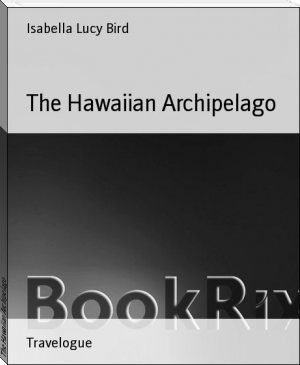The Hawaiian Archipelago by Isabella Lucy Bird (librera reader txt) 📖

- Author: Isabella Lucy Bird
Book online «The Hawaiian Archipelago by Isabella Lucy Bird (librera reader txt) 📖». Author Isabella Lucy Bird
I.L.B.
LETTER VII.
HILO, HAWAII.
The white population here, which constitutes "society," is very small. There are two venerable missionaries "Father Coan" and "Father Lyman," the former pastor of a large native congregation, which, though much shrunken, is not only self-sustaining, but contributes $1200 a year to foreign missions, and the latter, though very old and frail, the indefatigable head of an industrial school for native young men. Their houses combine the trimness of New England, with the luxuriance of the tropics; they are cool retreats, embowered among breadfruit, tamarind, and bamboo, through whose graceful leafage the blue waters of the bay are visible. Innumerable exotics are domesticated round these fair homesteads. Two of "Father Lyman's" sons are influential residents, one being the Lieutenant-Governor of the island. Other sons of former missionaries are settled here in business, and there are a few strangers who have been attracted hither. Dr. Wetmore, formerly of the mission, is a typical New Englander of the old orthodox school. It is pleasant to see him brighten into almost youthful enthusiasm on the subject of Hawaiian ferns. My host, a genial, social, intelligent American, is sheriff of Hawaii, postmaster, etc., and with his charming wife (a missionary's daughter), and some friends who live with them, make their large house a centre of kindliness, friendliness, and hospitality. Mr. Thompson, pastor of the foreign church, is a man of very liberal culture, as well as wide sympathies. The lady principal of the Government school is a handsome, talented Vermont girl, and besides being an immense favourite, well deserves her unusual and lucrative position.
There are hardly any young ladies, and very few young men, but plenty of rosy, blooming children, who run about barefoot all the year. Besides the Hilo residents, there are some planters' families within seven miles, who come in to sewing circles, church, etc. There is a small class of reprobate white men who have ostracized themselves by means of drink and bad morals, and are a curse to the natives. The half whites, among whom "Bill Ragsdale" is the leading spirit, are not numerous. Hilo has no carriage roads and no carriages: every one must ride or travel in a litter. People are very kind to each other. Horses, dresses, patterns, books, and articles of domestic use, are lent and borrowed continually. The smallness of the society and the close proximity are too much like a ship. People know everything about the details of each other's daily life, income, and expenditure, and the day's doings of each member of the little circle are matters for conversation. Indeed, were it not for the volcano and its doings, conversation might degenerate into gossip. There is an immense deal of personal talk; the wonder is that there is so little ill-nature. Not only is what everybody does here common property, but the sayings, doings, goings, comings, and purchases of every one in all the other islands are common property also, made so by letters and oral communication. It is all very amusing, and on the whole very kindly, and human interests are always interesting; but it has its perilous side. They are very kind to each other. There is no distress which is not alleviated. There is no nurse, and in cases of sickness the ladies take it by turns to wait on the sufferer by day and night for weeks, and even months. Such inevitable mutual dependence of course promotes friendliness.
The foreigners live very simply. The eating-rooms are used solely for eating, the "parlours" are always cheerful and tasteful, and the bedrooms very pretty, adorned with all manner of knick-knacks made by the ladies, who are indescribably deft with their fingers. Light Manilla matting is used instead of carpets. A Chinese man-cook, who leaves at seven in the evening, is the only servant, except in one or two cases, where, as here, a native woman condescends to come in during the day as a nurse. In the morning the ladies, in their fresh pretty wrappers and ruffled white aprons, sweep and dust the rooms, and I never saw women look more truly graceful and refined than they do, when engaged in the plain prose of these domestic duties. They make all their own dresses, and when any lady is busy and wants a dress in a hurry, two or three of them meet and make it for her. I never saw people live such easy pleasant lives. They have such good health, for one thing, partly no doubt because their domestic duties give them wholesome exercise without pressing upon them. They have abounding leisure for reading, music, choir practising, drawing, fern-printing, fancy work, picnics, riding parties, and enjoy sociability thoroughly. They usually ride in dainty bloomer costumes, even when they don't ride astride. All the houses are pretty, and it takes little to make them so in this climate. One novel fashion is to decorate the walls with festoons of the beautiful fern Microlepia tenuifolia, which are renewed as soon as they fade, and every room is adorned with a profusion of bouquets, which are easily obtained where flowers bloom all the year. Many of the residents possess valuable libraries, and these, with cabinets of minerals, volcanic specimens, shells, and coral, with weapons, calabashes, ornaments, and cloth of native manufacture, almost furnish a room in themselves. Some of the volcanic specimens and the coral are of almost inestimable value, as well as of exquisite beauty.
The gentlemen don't seem to have near so much occupation as the ladies. There are two stores on the beach, and at these and at the Court-house they aggregate, for lack of club-house and exchange. Business is not here a synonym for hurry, and official duties are light; so light, that in these morning hours I see the governor, the sheriff, and the judge, with three other gentlemen, playing an interminable croquet game on the Court-house lawn. They purvey gossip for the ladies, and how much they invent, and how much they only circulate can never be known!
There is a large native population in the village, along the beach, and on the heights above the Wailuku River. Frame houses with lattices, and grass houses with deep verandahs, peep out everywhere from among the mangoes and bananas. The governess of Hawaii, the Princess Keelikalani, has a house on the beach shaded by a large umbrella-tree and a magnificent clump of bamboos, 70 feet in height. The native life with which one comes constantly in contact, is very interesting.
The men do whatever hard work is done in cultivating the kalo patches and pounding the kalo. Thus kalo, the Arum esculentum, forms the national diet. A Hawaiian could not exist without his calabash of poi. The root is an object of the tenderest solicitude, from the day it is planted until the hour when it is lovingly eaten. The eating of poi seems a ceremony of profound meaning; it is like the eating salt with an Arab, or a Masonic sign. The kalo root is an ovate oblong, as bulky as a Californian beet, and it has large leaves, shaped like a broad arrow, of a singularly bright green. The best kinds grow entirely in water. The patch is embanked and frequently inundated, and each plant grows on a small hillock of puddled earth. The cutting from which it grows is simply the top of the plant, with a little of the tuber. The men stand up to their knees in water while cultivating the root. It is excellent when boiled and sliced; but the preparation of poi is an elaborate process. The roots are baked in an underground oven, and are then laid on a slightly hollowed board, and beaten with a stone pestle. It is hard work, and the men don't wear any clothes while engaged in it. It is not a pleasant-looking operation. They often dip their hands in a calabash of water to aid them in removing the sticky mass, and they always look hot and tired. When it is removed from the board into large calabashes, it is reduced to paste by the addition of water, and set aside for two or three days to ferment. When ready for use it is either lilac or pink, and tastes like sour bookbinders' paste. Before water is added, when it is in its dry state, it is called paiai, or hard food, and is then packed in ti leaves in 20 lb. bundles for inland carriage, and is exported to the Guano Islands. It is a prolific and nutritious plant. It is estimated that forty square feet will support an Hawaiian for a year.
The melon and kalo patches represent a certain amount of spasmodic industry, but in most other things the natives take no thought for the morrow. Why should they indeed? For while they lie basking in the sun, without care of theirs, the cocoanut, the breadfruit, the yam, the guava, the banana, and the delicious papaya, which is a compound of a ripe apricot with a Cantaloupe melon, grow and ripen perpetually. Men and women are always amusing themselves, the men with surf-bathing, the women with making leis--both sexes with riding, gossiping, and singing. Every man and woman, almost every child, has a horse. There is a perfect plague of badly bred, badly developed, weedy looking animals. The beach and the pleasant lawn above it are always covered with men and women riding at a gallop, with bare feet, and stirrups tucked between the toes. To walk even 200 yards seems considered a degradation. The people meet outside each others' houses all day long, and sit in picturesque groups on their mats, singing, laughing, talking, and quizzing the haoles, as if the primal curse had never fallen. Pleasant sights of out-door cooking gregariously carried on greet one everywhere. This style of cooking prevails all over Polynesia. A hole in the ground is lined with stones, wood is burned within it, and when the rude oven has been sufficiently heated, the pig, chicken, breadfruit, or kalo, wrapped in ti leaves is put in, a little water is thrown on, and the whole is covered up. It is a slow but sure process.
Bright dresses, bright eyes, bright sunshine, music, dancing, a life without care, and a climate without asperities, make up the sunny side of native life as pictured at Hilo. But there are dark moral shadows, the population is shrinking away, and rumours of leprosy are afloat, so that some of these fair homes may be desolate ere long. However many causes for regret exist, one must not forget that only forty years ago the people inhabiting this strip of land between the volcanic wilderness and the sea were a vicious, sensual, shameless herd, that no man among them, except their chiefs, had any rights, that they were harried and oppressed almost to death, and had no consciousness of any moral obligations. Now, order and external decorum at least, prevail. There is not





Comments (0)